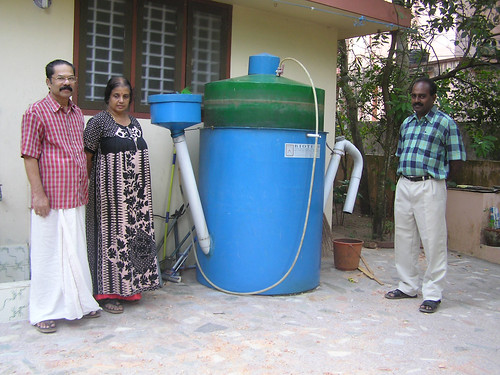
(pic: cooking on biogas in Nepal)
In the first of a new series, Carla Jones highlights some impressive biogas projects in Asia and Africa.The way biogas works is quite simple: take an airtight container (usually a brick chamber under the ground), fill it with some organic matter (manure, human waste or kitchen waste are the most common), and let the bacteria break it down. What comes out is biogas, that can be burned for cooking. The residue is a nutrient-rich fertilizer for crops.
Typically, a single fixed-dome biogas system is made from brick and sits underground. Many of our winners, though, have taken this design further. VK-NARDEP has developed a small bamboo-framed model, ARTI has designed a ‘balcony’ digester for apartments, and KIST in Rwanda has built a system of five interlocking chambers.

(KIST installing a large biogas system at a Rwandan prison)
Biogas has great potential in many settings. Schools, prisons, homes and farms can all benefit.

(Eating lunch cooked on biogas, Tania School, Kenya)
The chamber is fed from readily available organic components, from toilet sewage and livestock manure to kitchen waste.

(Portable household biogas plant in Kerala, India)
Imagine saving two hours a day of collecting firewood, avoiding the dangerous smoke from your kitchen, and ridding your community from the stench and danger of animal waste. For 100,000 pig-farming households in Vietnam, biogas is achieving just that. Elsewhere it is achieving even more. In Shaanxi Province, China, families have an extra $380 a year from saved fuelwood and the income from extra crops. Urban users of compact biogas systems in India save half of their LPG use. In Karnataka, India, SKG Sangha has ensured the residue from biogas increases its value through vermicomposting, which brings extra income.
And biogas helps the surrounding environment. In Shaanxi Province, China, each biogas digester saves 4.5 tonnes of fuelwood per year, avoiding deforestation in a region that suffers soil erosion and dust storms. In Rwanda, the KIST programme saves 1,000 tonnes of CO2 a year.
The most successful projects engage the end-user and wider community over the longer term. They employ and train local technicians to install the system and to provide after-sale service. The programme operated by the Vietnamese Ministry for Agriculture and Rural Development in partnership with the Dutch organisation SNV employs 1,800 masons who now, as a result of the success of the scheme, install as many systems as self-employed masons as they do within the government programme. The support from the Biogas Sector Partnership (BSP) in Nepal has helped to ensure there are 11,000 long-term jobs within the biogas sector. Their success is reflected in the regional development of technical capacity and demand in the sector as a whole.



No comments:
Post a Comment